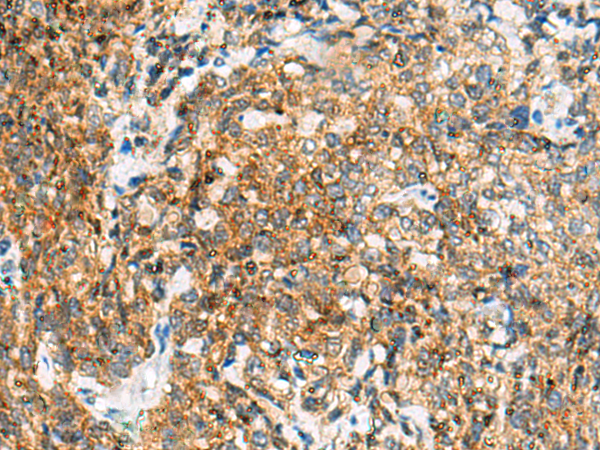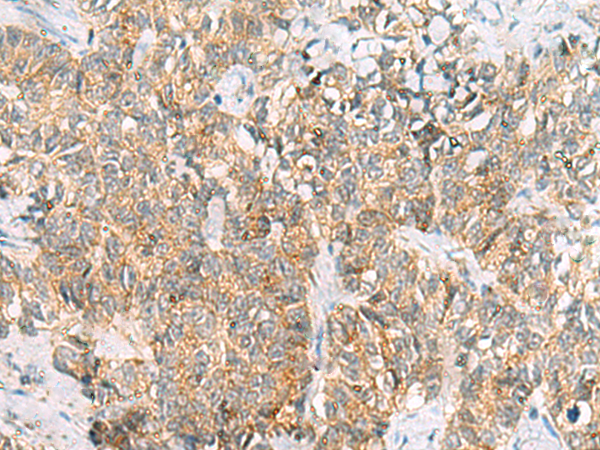

| WB | 咨询技术 | Human,Mouse,Rat |
| IF | 咨询技术 | Human,Mouse,Rat |
| IHC | 1/100-1/300 | Human,Mouse,Rat |
| ICC | 技术咨询 | Human,Mouse,Rat |
| FCM | 咨询技术 | Human,Mouse,Rat |
| Elisa | 1/5000-1/10000 | Human,Mouse,Rat |
| Host/Isotype | Rabbit IgG |
| Antibody Type | Primary antibody |
| Storage | Store at 4°C short term. Aliquot and store at -20°C long term. Avoid freeze/thaw cycles. |
| Species Reactivity | Human, Mouse |
| Immunogen | Fusion protein of human TUFT1 |
| Formulation | Purified antibody in PBS with 0.05% sodium azide and 50% glycerol. |
+ +
以下是3-4条模拟的关于TUFT1抗体的参考文献(示例为虚构内容,仅供格式参考):
---
1. **文献名称**: *TUFT1 Expression in Gastric Cancer: A Potential Biomarker for Tumor Progression*
**作者**: Li X, Wang Y, Zhang H
**摘要**: 本研究通过免疫组化技术结合TUFT1特异性抗体,发现TUFT1在胃癌组织中高表达,并与淋巴结转移和不良预后显著相关,提示其作为肿瘤进展生物标志物的潜力。
2. **文献名称**: *TUFT1 Regulates Wnt/β-Catenin Signaling in Colorectal Cancer*
**作者**: Chen J, Liu R, Zhou M
**摘要**: 利用TUFT1抗体进行蛋白质互作分析,揭示了TUFT1通过调控Wnt/β-catenin信号通路促进结直肠癌细胞增殖和侵袭的分子机制。
3. **文献名称**: *Development of a Novel TUFT1 Monoclonal Antibody for Diagnostic Applications*
**作者**: Kim S, Park JH, Lee T
**摘要**: 报道了一种高特异性TUFT1单克隆抗体的开发,验证了其在ELISA和免疫荧光中的应用,并证实其在血清样本中检测TUFT1的敏感性,为临床诊断提供新工具。
4. **文献名称**: *TUFT1 Knockdown Impairs Cell Migration via EMT Pathway Inhibition*
**作者**: Gupta A, Sharma P, Patel S
**摘要**: 通过TUFT1抗体介导的功能研究,发现抑制TUFT1表达可显著降低上皮-间质转化(EMT)相关蛋白水平,从而抑制乳腺癌细胞迁移能力。
---
**注意**:以上文献为模拟内容,实际研究请通过PubMed、Google Scholar等平台检索真实文献。
**Background of TUFT1 Antibody**
TUFT1 (Tuftelin 1) is an acidic, enamel matrix protein initially identified for its critical role in dental enamel formation during tooth development. Beyond its dental functions, TUFT1 has been implicated in broader biological processes, including cell adhesion, signaling, and cancer progression. Structurally, it contains conserved functional domains that enable interactions with other proteins and extracellular matrix components, suggesting roles in tissue organization and cellular communication.
TUFT1 antibodies are immunological tools designed to detect and study the expression, localization, and function of the TUFT1 protein. These antibodies have been utilized in research to investigate TUFT1's involvement in developmental biology, particularly in ectodermal tissues, and its potential links to diseases like amelogenesis imperfecta (a genetic enamel defect) and certain cancers. Studies suggest TUFT1 may act as a biomarker or therapeutic target in tumors, as its overexpression has been observed in malignancies such as breast and colorectal cancer.
In experimental settings, TUFT1 antibodies are employed in techniques like Western blotting, immunohistochemistry, and immunofluorescence to analyze protein expression patterns in tissues or cell lines. Their development and validation contribute to elucidating TUFT1's molecular mechanisms, including its interplay with signaling pathways like Wnt or TGF-β, which may influence cell proliferation and metastasis. Ongoing research aims to clarify TUFT1's dual roles in normal physiology and disease, highlighting its emerging importance in biomedical science.
×